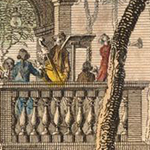Marylebone Gardens
Names
- Marylebone Gardens
- Marybone Gardens
Street/Area/District
- Marylebone Gardens
Maps & Views
- 1741–5 London, Westminster, Southwark & 10 miles round (Rocque): Marylebone Gardens
- 1746 London, Westminster & Southwark (Rocque): Marybone Gardens
- 1761 London (Dodsley): Marybone Gardens
Descriptions
from the Grub Street Project (2005–present)
See Marylebone Gardens, by Paul F. Rice.
from London Past and Present: Its History, Associations, and Traditions, by Henry Benjamin Wheatley and Peter Cunningham (1891)
Marylebone Gardens, a place of entertainment famous during the latter part of the 17th and the first three-quarters of the 18th century, was situated in the fields at the back of the manor-house, on ground now occupied by Beaumont Street and part of Devonshire Street. It occupied a considerable space, was encompassed with "a brick wall set with fruit trees," was diversified with gravel walks and lawns, and a great "circular walk of 485 paces, and six broad." In the centre was a bowling-green "112 paces one way, 88 another," walks and green being "double set with quickset hedges, full-grown and kept in excellent order, and indented like town walls." The carriage entrance was in High Street, the back entrance was from the fields. The orchestra stood on the site of what is now No. 17 Devonshire Place.
May 7, 1668.—Then we abroad to Marrowbone, and there walked in the garden, the first time I ever was there, and a pretty place it is.—Pepys.
The bowling-green was a chief attraction. Locke, writing in 1699 directions for "a foreigner about to visit England," says:—
The sports of England which perhaps a curious stranger would be glad to see, are horse-racing, hawking, and hunting. Bowling.—At Marebone and Putney he may see several persons of quality bowling two or three all the sunmier.—Lord King, Life and Letters of John Locke, p. 153, ed. 1858.
In rain to Marrobone no Bowler goes.
D'Urfey, Prol. to Massaniello, 1699.
Among the "persons of quality" who a little later might be seen bowling here, was Sheffield, Duke of Buckingham (d. 1721). Lady Mary Wortley alludes to his Grace's fondness for this place.
Some Dukes at Marybone bowl time away.
After I have dined (either agreeably with friends, or at worst with better company than your country neighbours), I drive away to a place of air and exercise, which some constitutions are in absolute need of; agitation of the body and diversion of the mind being a composition for health above all the skill of Hippocrates.—Sheffield, Duke of Buckingham (Works, vol. ii. p. 256.)1
Here, at the end of the season, as Quin told Pennant, the duke gave a dinner to the chief frequenters of the place, drinking the toast which he thought appropriate, "May as many of us as remain unhanged next spring meet here again." A few years later the gardens were enlarged, a spacious orchestra was erected, an organ by Bridge was added, and evening concerts of considerable pretension were given, some of the best singers and instrumental performers being usually engaged. About the middle of the century John Trusler, the father of Dr. Trusler, kept the gardens for several years. He was a cook, and his dinners and public breakfasts came into vogue. Miss Trusler, his daughter, made the popular Marylebone tarts and cakes. "Tarts of a twelvepenny size," says the Advertisement of May 1760, "will be made every day from one to three o'clock. ... The almond cheesecakes will be always hot at one o'clock as usual; and the rich seed and plum cakes sent to any part of the town, at 2s. 6d. each. Coffee, tea, and chocolate, at any time of the day, and fine Epping butter may also be had." The evening concerts were varied by pyrotechnic displays, "splendid beyond conception." Torr&eqcute; for many years prepared the fireworks with great success. "Gray," said Johnson, "was the very Torr´ of poetry; played his coruscations so speciously that his steel dust is mistaken by many for a shower of gold."2 It is a curious illustration of the condition of the roads round London in the middle of the 18th century that in 1746 the proprietor of the gardens engaged "a guard of soldiers" to protect visitors to and from London; and as late as 1764 Mr. Lowe, the then lessee, offered a teward of 10 guineas for the apprehension of "any highwayman found on the road to the Gardens." In 1769 Dr. Samuel Arnold, the eminent composer, took a lease of the gardens and wrote several pieces for it, but his management was unsuccessful, and he lost £10,000 by the speculation. James Hook, the father of Theodore Hook, composed many songs whilst the gardens were under Arnold's management; and a few years later (1773) Dr. Arne conducted the performance of his popular glees and catches. But the gardens were declining in public estimation. Entertainments, dramatic recitals, fantoccini, and sleight of hand exhibitions were successively tried, and at length came the end. In 1777–1778 the gardens were finally closed, and shortly after the site passed into the hands of the builder.
1 The duke adds in a note that the place was "Marybone."
2 Hawkins's Apophthegms.
Smith's Book for a Rainy Day.
